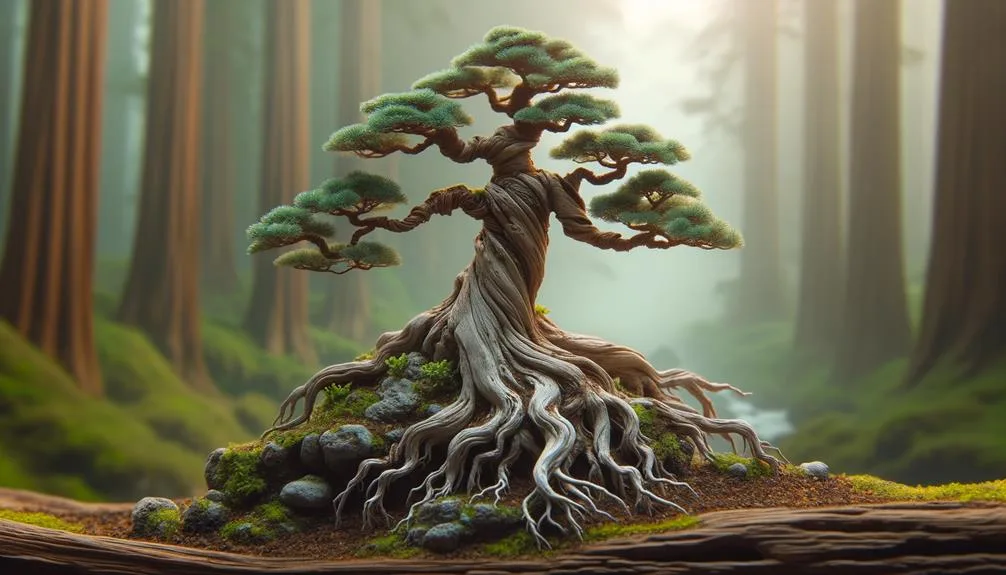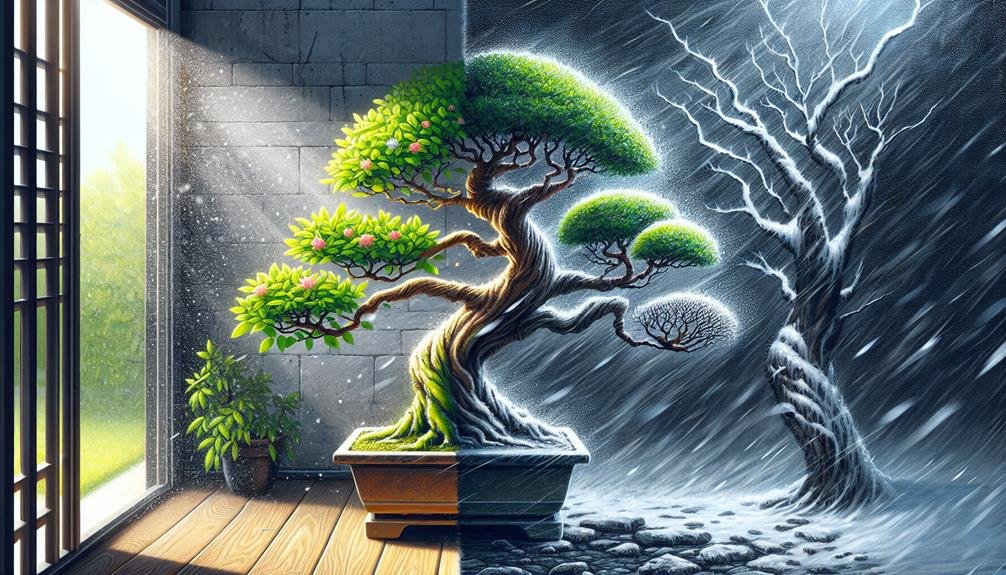Indoor Vs. Outdoor Bonsai: Exploring the Differences in Care
When it comes to the art of bonsai, one crucial consideration is understanding the variations in care for indoor vs. outdoor bonsai trees. Drawing inspiration from the rich traditions of ancient Eastern culture, I have discovered the remarkable fusion of horticulture and aesthetics in crafting miniature representations of nature.
Caring for bonsai trees requires careful attention to the distinct challenges and advantages posed by their indoor or outdoor environments. From managing light requirements and temperature control to establishing appropriate watering routines and effectively handling pests, the care of bonsai trees significantly differs based on whether they are raised indoors or outdoors.
Join me on this enlightening journey as we explore the complexities and nuances of indoor vs. outdoor bonsai care. Together, we will expand our knowledge and skills in this esteemed tradition, ensuring the health, vitality, and longevity of our treasured bonsai trees.
Key Takeaways
- Indoor bonsai require high humidity levels and filtered sunlight or grow lights, while outdoor bonsai need a winter dormant period and protection from extreme conditions.
- Selecting the right bonsai species is crucial for successful cultivation, with ficus, aralia, azalea, and Norfolk pine being popular choices for indoor bonsai, and junipers, maples, elms, and pines being common outdoor bonsai species.
- Creating ideal bonsai environments involves ensuring temperature suitability, providing appropriate light, monitoring humidity levels, and balancing water and oxygen needs.
- Prioritizing bonsai tree health is essential, with regular monitoring, proper watering and drainage, protection from harsh weather, checking for pests and diseases, and seeking advice from experts or local clubs.
Understanding Indoor Bonsai Care
Indoor bonsai care for varieties such as ficus, aralia, azalea, Norfolk pine, serissa, gardenia, and boxwood, necessitates understanding their specific needs for sunlight, temperature, and humidity. These Indoor Bonsai Trees require specific indoor conditions to thrive, and understanding indoor bonsai care is vital to ensure they remain healthy.
Most common indoor bonsai plants, particularly those with woody stems, can be wired to control their growth direction. This aspect of Bonsai Tree Care allows for the creation of aesthetically pleasing forms, a cherished aspect of bonsai indoors cultivation.
Tropical and subtropical bonsai, often grown indoors, cannot tolerate temperatures below 40-50 degrees F. They require filtered sunlight from east, south, or west windows, or alternatively, supplementary grow lights for 12 hours daily.
A key difference between indoor and outdoor bonsai is the need for high humidity levels for the former. Indoor conditions, particularly heating or air conditioning, can lead to dry air, which is not ideal for a healthy bonsai. Therefore, maintaining adequate humidity is crucial in Bonsai Care for indoor varieties.
Understanding these specific requirements will ensure your indoor bonsai plants flourish.

Key Factors for Outdoor Bonsai
Transitioning to the realm of outdoor bonsai cultivation, understanding certain key factors is paramount for maintaining the health and aesthetic appeal of these miniature trees. Some salient points to consider include:
- The importance of winter dormant periods for deciduous varieties, which can be facilitated by a cold frame.
- Providing protection from extreme conditions, particularly harsh winds that can lead to freeze-drying.
- Selecting suitable tree species for the outdoor environment, including tropical and subtropical varieties as well as hardy junipers, maples, and elms.
- Understanding the water requirements of your chosen species, which can range from daily watering to less frequent interventions.
- Offering adequate sunlight to promote photosynthesis and healthy growth.
Each of these components plays a crucial role in the successful cultivation of outdoor bonsai, highlighting the intricate balance between nature and nurture that characterizes this ancient art form.
Popular Indoor and Outdoor Species
Popular Indoor and Outdoor Species that excel in both indoor and outdoor environments include approximately 75 sought-after species that offer a distinctive aesthetic charm and specific care requirements.
For indoor cultivation, ficus, aralia, azalea, Norfolk pine, serissa, gardenia, and boxwood are popular choices. These miniature trees, often used as house plants, thrive in indoor conditions and are tolerant of indoor humidity levels. However, keep in mind that these tropical and subtropical indoor bonsai cannot tolerate temperatures below 40-50 degrees F.
For outdoor bonsai, which are typically grown outdoors, junipers, maples, elms, pines, ginkgo, hawthorn, and flowering crab apple are popular species. They require a winter dormant period, crucial for their health. This necessitates winter protection in northern climates.
Whether indoors or outdoors, the right choice of bonsai species is crucial for a successful cultivation. Understanding the different requirements of indoor versus outdoor bonsai trees can help enthusiasts maintain the health of these beautiful plants, ensuring their longevity and enhancing their appeal.
Creating Ideal Bonsai Environments
To create ideal bonsai environments, it is imperative to consider specific factors such as temperature, light, humidity, water and oxygen needs, and the choice of suitable bonsai species for indoor or outdoor settings. Creating ideal bonsai environments require a well-thought-out approach, especially when it comes to indoor and outdoor care differences.
Here are key factors to consider:
- Ensure temperature suitability for your bonsai. Keep indoor bonsai away from temperatures below 40-50 degrees F, and protect outdoor bonsai from freezing winter temperatures.
- Provide appropriate light for your tree. Indoor bonsai need filtered sunlight from east, south, or west windows. Outdoor bonsai require sufficient sunlight for healthy growth.
- Monitor humidity levels. Indoor environments typically have lower humidity, leading to faster transpiration in bonsai trees. Misting can help reduce this stress.
- Balance water and oxygen needs. Water your bonsai carefully to avoid root system damage and make sure oxygen isn’t displaced.
- Choose a suitable bonsai species. Consider the adaptability and care requirements of specific tree species for indoor or outdoor settings.
Prioritizing Bonsai Tree Health
Regarding cultivation, bonsai tree health should be of utmost priority, requiring regular monitoring and appropriate care to ensure balance in watering, lighting, and temperature. Prioritizing bonsai tree health is not just a need, but a responsibility for those who have chosen to be bonsai enthusiasts.
Whether being grown indoors or outdoors, bonsai trees should be watered every day, and the soil should have proper drainage to prevent waterlogging. It’s crucial to understand the indoor vs. outdoor bonsai: care differences. For instance, outdoor bonsai may need protection from harsh weather conditions, while indoor bonsai require controlled humidity levels.
During the growing season, it’s important to keep an eye on the soil’s moisture content and prevent it from drying out. The bonsai’s health can be significantly affected by the weather conditions and humidity levels. Regular checks for pests and diseases are essential for maintaining a healthy and beautiful bonsai.
Bonsai tree health should be prioritized above aesthetics. The tree’s overall well-being, strong root system, and vibrant foliage are more important than just its appearance. Aspiring bonsai cultivators should seek advice from experts or local clubs to ensure their bonsai flourish.
Frequently Asked Questions
Are Indoor Bonsai Trees Hard to Take Care Of?
How Do You Take Care of an Outdoor Bonsai Tree?
Outdoor bonsai tree care involves regular watering, appropriate fertilization, winter protection, and pest control. Proper sunlight exposure, pruning techniques, soil selection, repotting procedures, disease prevention, and growth monitoring are also essential for optimal health.
What Happens if You Plant a Bonsai Outside?
Planting a bonsai outside exposes it to natural elements, impacting its acclimatization, soil selection, and watering frequency. External pollutants, outdoor pests, climate impact, and potential sunburn are considerations, as are specific variety and pruning needs.
What Is the Hardest Bonsai to Care For?
Tropical indoor bonsai plants like ficus and azalea present unique challenges, including complex repotting, pest management, watering difficulties, and temperature sensitivities. Their specific light, humidity, and soil quality requirements demand meticulous care and expertise.




